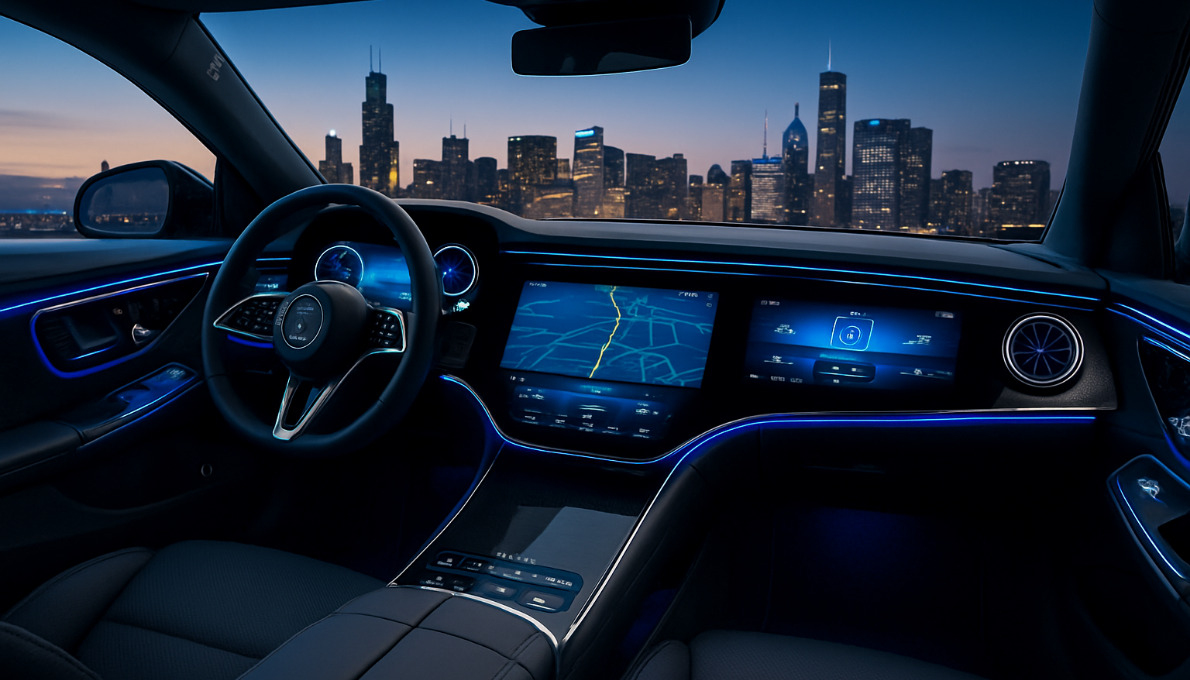Luxury Car Technology: 10 Powerful Innovations for 2025
The Convergence of Opulence and Innovation
Remember the days when power windows and leather seats defined luxury in cars? Those days are long gone. Today, luxury car technology has transformed what it means to experience automotive excellence, blending the warmth of traditional craftsmanship with breathtaking digital innovation.
When you slide into a modern luxury vehicle, you’re not just sitting in a car – you’re entering a personalized sanctuary designed around your preferences. The buttery-soft leather and hand-finished wood trim now share the spotlight with digital cockpits spanning up to 56 inches, complete with augmented reality navigation that makes finding your destination feel like a video game.
What truly sets today’s luxury vehicles apart isn’t just what you can touch, but what you can’t see. Behind the scenes, Advanced Driver-Assistance Systems quietly monitor your surroundings, keeping you centered in your lane and maintaining perfect distance from the car ahead. Meanwhile, electric powertrains deliver heart-racing acceleration with whisper-quiet operation and ranges now exceeding 500 miles on a single charge.
“In the early days of the automotive industry, luxury cars were defined by their craftsmanship and opulent features,” notes one automotive historian. “Today, they’re just as likely to be defined by their computing power and software capabilities.”
This shift has dramatically changed buyer behavior. Industry surveys show that 86% of luxury car buyers cite the pure enjoyment of driving as their main motivation for purchase. Yet interestingly, only 37% consider themselves brand loyalists. The message is clear: innovation trumps tradition for today’s luxury car buyer.
Your relationship with your vehicle has never been more intimate. Biometric systems recognize you before you even touch the door handle. AI assistants learn your preferences, from your favorite temperature to your morning commute route. Even your wellness is catered to, with cabin air purification systems, customizable fragrance diffusers, and ambient lighting that syncs perfectly with your music to create a mood-enhancing environment.
Connectivity has become the invisible thread weaving your digital life together. Your luxury car now seamlessly integrates with your smartphone, smart home, and even receives software updates while you sleep – much like your phone, but infinitely more impressive.

The evolution has been remarkable. What began with CD changers and basic navigation systems has transformed into AI-driven experiences that anticipate your needs before you realize them yourself. Today’s luxury car technology doesn’t just respond to commands – it learns, adapts, and creates experiences custom specifically to you.
The Digital Evolution of Automotive Luxury
The journey from purely mechanical marvels to software-defined vehicles represents perhaps the most significant change in automotive history. Today’s luxury car technology seamlessly blends the tangible craftsmanship of traditional coachbuilding with the intangible power of code and connectivity.
Remember when luxury meant simply having leather seats and wood trim? Those days are long gone. Now, BMW’s ambient lighting systems mirror the quilting patterns on seats, with colors that can be personalized to your mood or matched to driving modes. It’s this beautiful marriage of physical craftsmanship and digital innovation that defines modern luxury vehicles.
This evolution directly responds to how luxury car buyers have changed. Research shows today’s premium car purchasers fall into distinct personality types: the heritage-loving collectors who appreciate tradition, tech-forward innovation seekers always wanting the latest features, driving enthusiasts focused on performance, and status-conscious buyers who simply must have what’s newest and most exclusive.
One concern keeps popping up in conversations with luxury car owners—residual value. About 45% worry their high-tech purchases might become technologically outdated too quickly, especially with electric vehicles where battery technology and software are evolving at breakneck speed.
From Hand-Stitched Leather to Software-Defined Vehicles
The modern luxury car has transformed into a sophisticated computer on wheels while maintaining its mechanical soul. Take the Bentley Continental GT with its remarkable rotating dashboard—a $4,770 option featuring a three-sided display that neatly rotates between a 12.3-inch touchscreen, three analog dials, or a clean wood veneer. This 40-part mechanism perfectly illustrates how traditional craftsmanship and digital innovation can coexist beautifully.
As one luxury car designer shared with us, “It’s not enough to simply add screens. The technology must feel integrated with the vehicle’s character and heritage.” This philosophy guides how premium automakers approach innovation.
The shift has led to cleverly designed modular vehicle architectures where hardware components can be upgraded independently of software. Mercedes-Benz now stores approximately 800 personalization parameters in cloud-based user profiles that follow owners between vehicles—your perfect seat position, favorite radio stations, and climate preferences move with you from car to car.
Over-the-air updates have become standard practice, with Tesla pioneering the approach and traditional luxury brands following suit. These wireless updates can add entirely new features, boost performance, and fix issues without requiring a dealership visit—significantly extending the technological lifespan of these premium vehicles.
Why Technology Became the New Badge of Prestige
The elevation of technology to luxury’s primary differentiator stems from several compelling factors. Electric powertrains have completely redefined performance expectations with their instant torque and whisper-quiet operation. The Porsche Taycan exemplifies this shift, accelerating from 0-60 mph in just 2.4 seconds—performance that was once reserved exclusively for million-dollar hypercars.
AI assistants like Mercedes’ MBUX system have transformed our relationship with vehicles. These intelligent systems learn your preferences, anticipate your needs, and respond to natural conversation—creating a deeply personalized experience that traditional mechanical luxury simply couldn’t provide. Imagine your car knowing you’ll want the heat turned up based on the weather forecast, or that you typically call your partner during your evening commute.
Perhaps most visibly, immersive displays have revolutionized luxury interiors. The Mercedes EQS features a stunning 56-inch Hyperscreen spanning the entire dashboard, while the BMW 7 Series offers rear passengers a 31-inch 8K Theater Screen that transforms the backseat into a private cinema. As one reviewer enthusiastically put it, “This rules. I need to sit in that seat ASAP.”

Pillars of Modern Luxury Car Technology
The foundation of contemporary luxury car technology rests on several key innovations that transform the driving experience. These pillars collectively redefine what premium transportation means in the digital age.
Remember when car lights just helped you see at night? Those days are long gone. Today’s luxury vehicles feature Matrix LED and laser headlights that intelligently adjust their beam patterns to avoid blinding oncoming drivers while keeping your path perfectly illuminated. Inside the cabin, ambient lighting systems with thousands of color options sync with your music, navigation alerts, and driving modes, creating a personalized light show that improves every journey.
Sound systems in luxury cars have evolved from simple stereos to architectural marvels integrated into the vehicle’s very structure. Take the BMW 7 Series with its 40-speaker Bowers & Wilkins setup – it doesn’t just play music, it physically connects you to it. Special “seat exciters” vibrate in sync with bass notes to create what BMW calls “4D sound,” intensifying the feeling of acceleration and making every note come alive.
“Your car should know you better than your spouse does,” joked one luxury car designer I spoke with recently. It’s not far from reality – cloud-based profiles now store up to 800 personal parameters, from your preferred seat position to your favorite radio stations. Mercedes-Benz allows up to seven users to create these detailed profiles, which can follow you between compatible vehicles. Forget adjusting mirrors and seats every time you get in – your car recognizes you and adapts instantly.
Speaking of recognition, biometric access systems have made traditional keys almost obsolete in the luxury segment. The Genesis GV60’s Face Connect technology identifies your face as you approach, open uping the doors and preparing your personalized cabin environment before you even touch the handle. It’s like having an attentive butler who always knows exactly what you need.
Luxury Car Technology in ADAS
Advanced Driver-Assistance Systems represent some of the most sophisticated technology in modern luxury vehicles. Most premium brands now offer Level 2+ autonomy, where the car handles steering, acceleration, and braking in specific scenarios while you remain nominally in charge.
These systems rely on an impressive fusion of sensors – radar, lidar, cameras, and ultrasonic detectors all working in harmony to create a comprehensive view of your surroundings. The Mercedes-Benz S-Class employs more than 40 sensors to monitor its environment – more than some early spacecraft had!
What truly sets luxury ADAS apart is predictive capability. Audi’s pre-sense system can detect an imminent side impact and raise the suspension by 3 inches in just half a second, directing crash forces to the strongest parts of the vehicle structure. It’s like having a guardian angel that sees danger before you do.
Hands-free highway driving has become a reality in many luxury vehicles. GM’s Super Cruise system in Cadillac models lets you take your hands off the wheel on pre-mapped highways, though an infrared camera ensures you’re still paying attention to the road. It’s not quite time to take a nap behind the wheel, but the technology is getting impressively close to that science fiction future we’ve all imagined.
For those looking to master these sophisticated systems, our guide to Advanced Car Driving Techniques provides valuable insights into getting the most from your vehicle’s assistance features without becoming overly dependent on them.
Luxury Car Technology in Infotainment & Connectivity
Remember when a luxury car interior meant wood and leather? Today, it’s just as likely to mean screens – lots of them. “Pillar-to-pillar” displays that span the entire dashboard are becoming commonplace, with the 2025 Lincoln Nautilus featuring a particularly impressive example. These digital canvases transform the cabin into a customizable space that adapts to your needs and moods.
Voice and gesture control have evolved from frustratingly limited systems to sophisticated conversational interfaces. Mercedes-Benz’s “Hey Mercedes” system now understands natural language so well it can perform certain actions without the wake word, explain vehicle functions, control your smart home devices, and even recognize different passengers by their voice patterns. Wave your hand to answer a call or point at a vent to adjust airflow – it’s intuitive in a way early systems never were.
With 5G connectivity, your luxury car now has faster internet than many homes. The BMW 7 Series Theater Screen supports Amazon Fire TV streaming in crystal-clear 4K resolution over the car’s built-in 5G connection, turning the backseat into a mobile cinema experience that rivals dedicated home theaters.
Smart-home integration blurs the boundaries between your residence and your vehicle. Systems like Mercedes’ MBUX let you adjust your home thermostat as you approach or turn off lights after you’ve left. “Did I leave the garage door open?” is now a question you can answer and resolve from miles away.
These systems continue to advance in sophistication, as demonstrated by MBUX reaching a new level with its Zero Layer concept – an adaptive interface that uses AI to surface the most relevant functions based on context, eliminating the need to steer complex menus when you should be focusing on the road.
Luxury Car Technology in Powertrains
Battery innovation drives the electric luxury segment forward, with ranges continuing to increase at an impressive pace. The Lucid Air offers an industry-leading 516 miles on a single charge – enough to drive from Los Angeles to San Francisco without stopping, with range to spare for exploring when you arrive.
Not quite ready to go fully electric? Plug-in hybrids bridge the gap beautifully. BMW’s XM combines a twin-turbocharged V8 with electric motors to produce a staggering 738 horsepower while offering around 30 miles of electric-only range for emissions-free city driving.
One-pedal driving has transformed the EV experience in ways that are hard to explain until you’ve tried it. By using regenerative braking to slow the vehicle when you lift off the accelerator, it makes city driving noticeably less fatiguing while extending range through energy recovery. As one automotive journalist I spoke with explained, “One-pedal driving will change your world – once you try it, going back to traditional braking feels primitive.”
Active aerodynamics in luxury vehicles adjust the car’s shape for optimal efficiency or performance depending on your needs. The Mercedes EQS features automatic flaps, panels, and even wheel designs that reduce its drag coefficient to just 0.20 – the lowest of any production car and a big reason for its impressive range and whisper-quiet cabin.
Luxury Car Technology in Comfort & Wellness
Massaging seats have evolved from simple lumbar support to comprehensive wellness systems that would make a spa therapist jealous. Mercedes-Benz offers “hot stone” massage that combines heat and pressure patterns, while Audi provides up to 18 pneumatic cushions with seven massage programs. Long road trip? Your back might actually feel better when you arrive than when you departed.
Digital scent diffusers create personalized aromatic experiences that transform the cabin atmosphere. Lincoln’s Digital Scent system features microchip-equipped cartridges that disperse fragrances independently of the climate control system, with options like Mystic Forest and Serene Seashore to match your mood or destination.
“The available Lincoln Digital Scent feature is an in-cabin scent diffusion technology designed to inspire a feeling of relaxation and revitalization while creating an aromatic experience for drivers and passengers,” explains the company in its Lincoln Digital Scents information. It’s aromatherapy for the road.
Ambient lighting has become an art form, with systems featuring thousands of colors and dynamic patterns that respond to music, driving modes, and even navigation prompts. The Mercedes EQS features 190 individual LED elements that can display over 64 colors, creating a customizable environment that subtly improves your driving experience and passenger comfort.
Active noise cancellation uses the same technology as premium headphones, but on a cabin-wide scale. Microphones detect unwanted sounds, and speakers produce opposing sound waves that cancel them out – creating interiors quieter than ever before. Some systems can reduce road and wind noise by up to 10 decibels, which represents a halving of perceived noise levels.
Wellness modes tie these elements together for a holistic experience. Lincoln’s “Relax” mode, for example, coordinates seat massage, ambient lighting, audio, and fragrance to create a synchronized relaxation experience. It’s like having a spa treatment while commuting – turning drive time into “me time.”

Personalization & AI-Driven Experiences
The intersection of artificial intelligence and luxury car technology has created unprecedented levels of personalization. Modern luxury vehicles learn from their drivers, adapting to preferences and habits over time.
Machine learning profiles track everything from preferred seat positions to typical driving routes and even coffee stops. Mercedes-Benz’s MBUX system, for example, might suggest calling your spouse if you typically do so during your evening commute.
Predictive maintenance uses AI to analyze vehicle data and anticipate service needs before they become problems. BMW’s intelligent personal assistant can remind you of maintenance appointments and even schedule them based on your calendar availability.
Adaptive suspension systems use cameras to scan the road ahead and prepare the dampers for upcoming bumps or potholes. The Mercedes S-Class can lift individual wheels just before they encounter a pothole, dramatically improving ride comfort.
Ethernet vehicle networks have replaced traditional wiring harnesses in many luxury cars, enabling faster data transmission and more sophisticated functions. These networks can transfer up to 10 gigabits per second—enough bandwidth to support dozens of connected systems simultaneously.
Vehicle-to-everything (V2X) communication allows luxury cars to share data with other vehicles, infrastructure, and even pedestrians. This enables cooperative driving scenarios where vehicles coordinate movements for optimal traffic flow and safety.
Bespoke Settings at the Touch of an Algorithm
AI systems in luxury vehicles now learn driver habits with remarkable precision. The Audi A8’s AI traffic jam pilot, for example, observes how closely you prefer to follow other vehicles and adjusts its autonomous driving behavior accordingly.
Cloud portability ensures your preferences follow you between vehicles. BMW’s My BMW app stores your profile in the cloud, automatically configuring any compatible BMW to your preferences when you authenticate with your smartphone.
Virtual configurators have transformed how buyers customize their vehicles. Bentley’s digital configurator allows customers to visualize billions of possible combinations of exterior colors, wheel designs, interior materials, and technology packages before placing an order.
For those interested in how technology is changing manufacturing, our article on Automotive 3D Printing Applications explores how additive manufacturing is enabling unprecedented levels of customization.
Custom Interiors & Digital Craftsmanship
Biometric locks secure valuables within the vehicle. The Bentley Bentayga offers a fingerprint-secured storage compartment in the center console—perfect for storing watches, jewelry, or other valuables.
Augmented-reality head-up displays project navigation instructions directly onto the road ahead. BMW’s AR system overlays directional arrows on a live camera feed, making complex intersections easier to steer.
Scented and lit ambience creates a multi-sensory luxury experience. The Mercedes-Maybach GLS offers an “Air Balance” package with a choice of fragrances, ionization, and filtration, all controlled through the infotainment system.
As one luxury car owner told us, “My car knows me better than some of my friends do. It adjusts everything to my preferences before I even ask, from the temperature to the music to the driving mode.”
Sustainability and the Road Ahead
Gone are the days when luxury meant excess without consideration. Today’s luxury car technology accepts environmental responsibility as enthusiastically as it does performance and comfort. The green revolution isn’t just happening—it’s being driven in style.
Walking through a modern luxury car factory is nothing like the industrial complexes of yesteryear. Porsche’s Leipzig facility, where the sleek Taycan rolls off the production line, hums entirely on renewable electricity. The only thing these manufacturers are burning through these days is innovation.
“Our customers expect excellence in everything—including our environmental commitment,” a Bentley spokesperson told me during a recent factory tour. “Luxury and sustainability are no longer opposing forces.”
Inside these vehicles, traditional materials are getting eco-friendly makeovers. BMW now transforms discarded fishing nets into stylish floor mats and interior trim pieces. Even Bentley, the epitome of old-world opulence, offers tweed interior options crafted from sustainable wool that feels as premium as it is responsible.
The structural components are evolving too. Mercedes-Benz engineers have cleverly repurposed carbon fiber manufacturing waste into recycled composites for their electric EQ models. What was once headed to landfills now helps form the bones of some of the world’s most advanced vehicles.
End-of-life considerations have become part of the luxury equation as well. Audi’s closed-loop battery recycling system recovers more than 90% of valuable materials from used EV batteries, giving these precious resources new life in future power cells. It’s circular thinking at its finest.
The carbon neutrality race is on among premium brands. Bentley has committed to end-to-end carbon neutrality by 2030, while Volvo aims to achieve climate neutrality by 2040. These aren’t vague promises—they’re detailed roadmaps with accountability built in.
For readers interested in the broader electric revolution reshaping our roads, Scientific research on EV adoption offers fascinating insights into how consumer preferences are evolving alongside the technology.
Electric Luxury as a Status Statement
The Tesla-triggered EV revolution has gone fully mainstream in the luxury segment, where long ranges and rapid charging have become the new benchmarks for excellence. The Mercedes EQS, Lucid Air, and BMW i7 all offer ranges exceeding 300 miles, with some approaching or surpassing the magical 500-mile mark on a single charge.
“I used to brag about horsepower,” one Lucid Air owner confessed to me. “Now I talk about range and charging speed. The status symbols have changed, but the pride of ownership hasn’t.”
Speaking of charging, premium automakers aren’t waiting for others to build infrastructure. Porsche and Audi’s joint venture, Ionity, is establishing a network of high-power charging stations throughout Europe that can add 200 miles of range in roughly the time it takes to enjoy a proper espresso.
Perhaps most surprisingly, the absence of sound has become luxury’s new soundtrack. “The silence in my EQS creates a sense of serenity that my previous S-Class could never match, even with its impressive noise cancellation,” a Mercedes owner explained during a recent test drive event. “It’s not just quiet—it’s peaceful.”
The market is approaching a fascinating inflection point. Research indicates about 20% of luxury buyers are already considering pure electric vehicles for their next purchase, with another 20% leaning toward hybrids. The internal combustion engine, once the beating heart of automotive passion, is gradually becoming optional in the premium segment.
Future Horizons: Autonomous Lounges & Connected Ecosystems
The luxury vehicle of tomorrow won’t just drive itself—it’ll seamlessly integrate with our increasingly connected world. Mercedes-Benz is already testing systems that communicate with traffic lights, allowing vehicles to “know” when lights will change and adjust speed accordingly for the smoothest possible journey.
Subscription features represent another frontier, allowing owners to activate certain functions on demand. BMW has experimented with subscription-based heated seats and steering wheels, though customer feedback has been, shall we say, less than toasty warm. The industry is still finding the right balance between flexibility and value.
As vehicles become more connected, security concerns naturally follow. The latest edge-computing security systems process sensitive data within the vehicle rather than sending it to cloud servers, creating a fortress against potential cyber threats. Your luxury car may soon be more secure than your home computer.

Navigating Ownership in a High-Tech Era
Owning a high-tech luxury vehicle today is a bit like dating someone who’s constantly reinventing themselves—exciting, but occasionally complicated. The explosion of luxury car technology has completely transformed what it means to own a premium automobile.
Let’s talk about resale value—the elephant in the showroom that many salespeople prefer to avoid. It’s not the charging infrastructure that makes potential buyers hesitate about that gorgeous electric sedan; it’s uncertainty about how much it will be worth in a few years. When today’s cutting-edge tech becomes tomorrow’s outdated feature, what happens to your investment?
“I love my car’s features now, but I worry about how quickly they’ll become obsolete,” confided one luxury EV owner I spoke with recently. “It’s like buying the latest iPhone—amazing today, but potentially outdated in 18 months.”
The longevity of over-the-air updates varies dramatically between brands. Tesla has been supporting vehicles with updates for nearly a decade, while some traditional luxury manufacturers commit to much shorter windows. Before signing on the dotted line, it’s worth asking: “How long will my car continue receiving meaningful software improvements?”
Cybersecurity has emerged as another crucial consideration. As vehicles become more connected, they also become more vulnerable to digital threats. Premium manufacturers now employ dedicated security teams—automotive “ethical hackers” who work tirelessly to stay ahead of potential vulnerabilities. Still, it’s a constant cat-and-mouse game between security experts and those with less honorable intentions.
The service experience has evolved too. Nearly half of luxury buyers would happily opt for full garage management services where they never have to think about maintenance logistics. The dealer simply handles everything—picking up your vehicle when needed and returning it freshly serviced. For busy professionals, this hands-off approach represents the true luxury of time saved.
Smartphone apps have revolutionized how we interact with our vehicles between drives. BMW’s My BMW app lets you check your car’s status, schedule service appointments, and even receive diagnostic alerts while sitting at your desk or relaxing at home. It’s like having a personal assistant dedicated solely to your automotive needs.
For those who enjoy a more hands-on approach, our Ultimate Guide to Car Maintenance for 2025: From Basic to Advanced offers practical advice for keeping your high-tech chariot in perfect condition.
Ensuring Long-Term Appeal of Cutting-Edge Features
Smart manufacturers have acceptd modular hardware architecture—essentially making certain components upgradeable without replacing the entire vehicle. Think of it like upgrading the graphics card in your gaming PC rather than buying an entirely new system. Audi’s MIB infotainment system features a replaceable main computing module that can be updated as technology advances, potentially extending the “technological lifespan” of your vehicle.
Software support commitments vary wildly between brands. Some manufacturers clearly state they’ll provide updates for 4-7 years, while others keep it frustratingly vague. As one luxury car consultant told me, “The vehicle with the most features today might not be the one with the most capabilities five years from now if the manufacturer doesn’t prioritize software updates.”
Data privacy has become another hot-button issue. Our cars now know our daily routines, favorite destinations, voice patterns, and sometimes even our biometric data. Leading luxury brands have responded by providing granular control over what information is collected and how it’s used, including options to purge personal data when selling or returning a vehicle.
Balancing Cost, Reliability & Upgrade Paths
Calculating the true cost of ownership has become considerably more complex. That electric luxury sedan might cost more upfront but could save thousands in fuel and maintenance over its lifetime. The math isn’t always straightforward, especially when factoring in potential battery degradation and technology obsolescence.
Many savvy buyers now opt for technology-specific warranty extensions that protect those expensive screens, sensors, and computing systems beyond the standard warranty period. It’s peace of mind that can be well worth the additional investment.
Perhaps the most fascinating development is predictive diagnostics. Using artificial intelligence, luxury vehicles can now anticipate potential failures before they occur. Rolls-Royce’s Whispers app connects directly to vehicle systems, monitoring health in real-time and alerting both the owner and dealer to address issues before they leave you stranded.

As one service manager at a premium dealership explained to me, “We often know there’s an issue with a customer’s vehicle before they do. The car essentially calls home when it’s not feeling well.” It’s a level of proactive service that transforms the ownership experience from reactive problem-solving to preventative care.
Navigating luxury car ownership in this high-tech era requires asking different questions than buyers did a decade ago. But for those who do their homework, the rewards can be extraordinary—a vehicle that continues to evolve, improve, and delight long after you’ve driven it home.
Frequently Asked Questions about Luxury Car Technology
How safe are semi-autonomous features today?
Let’s be honest – those flashy commercials showing drivers taking their hands off the wheel can make semi-autonomous features seem almost magical. The reality? Today’s systems are impressive but still works in progress.
Luxury car technology like Mercedes Drive Pilot, BMW Highway Assistant, and Cadillac Super Cruise can confidently handle steering, acceleration, and braking on well-marked highways. But here’s the crucial part – you absolutely need to stay alert and ready to take over.
These systems are pretty clever about keeping tabs on their surroundings. They use multiple types of sensors (cameras, radar, and sometimes lidar) that work together like a team of cautious co-pilots. Many even watch you watching the road with driver-monitoring cameras that track your eye movements.
The safety data is encouraging – when used correctly, these systems do help prevent accidents. But they still get confused by heavy rain, snow, construction zones, or that driver who cuts across three lanes without signaling.
As one safety expert told me recently over coffee, “Think of it as having a talented teenage driver handling your car. Impressive skills, but you wouldn’t take a nap while they’re driving, would you?”
Will software updates really keep my car “future-proof”?
The term “future-proof” gets thrown around a lot in luxury car marketing, but let’s get real about what software updates can and can’t do.
Those over-the-air updates can absolutely breathe new life into your luxury car technology. They might add cool features (like Tesla famously adding Sentry Mode security), improve existing functions, or fix annoying bugs. But they can’t perform magic.
Think of it like smartphone updates – they can make your current phone better, but eventually, you’ll hit hardware limitations. A car without certain physical sensors simply can’t gain capabilities that require those sensors, no matter how clever the software update. Your 2023 model with 8GB of memory can’t suddenly run programs designed for 16GB.
The most update-friendly vehicles are those designed from the ground up to be software-defined. Tesla pioneered this approach, but traditional luxury brands have been catching up. Mercedes-Benz now offers meaningful updates that can genuinely improve your car years after purchase.
When shopping, don’t just ask “Does it get updates?” Instead, ask specific questions like “How many years of updates are guaranteed?” and “Will major feature additions cost extra?” The salesperson’s comfort level with these questions tells you a lot about the brand’s commitment.
Do electric luxury cars hold their value like traditional models?
This is the million-dollar question (sometimes literally!). The honest answer? Electric luxury cars generally don’t hold their value quite as well as traditional models yet, but the gap is closing fast.
Several unique factors affect electric luxury car technology depreciation:
Battery technology is evolving rapidly – today’s breakthrough is tomorrow’s baseline. A 250-mile range seemed impressive in 2020; now luxury EVs pushing 400+ miles make those earlier models seem limited.
Those generous government tax credits that made your initial purchase sweeter? They artificially inflate depreciation percentages since they effectively lower the starting price.
On the brighter side, some positive trends are emerging. Tesla has defied early predictions about catastrophic depreciation. Models with exceptional range and strong software support are establishing much better value retention than early EVs did.
“The market is maturing before our eyes,” a vehicle valuation specialist explained to me recently. “Premium electric models from established brands with ranges over 400 miles are holding value surprisingly well – especially those from manufacturers with proven track records of meaningful software updates.”
Interestingly, some electric luxury models are benefiting from lower maintenance costs in the resale equation. With fewer moving parts to wear out and no expensive engine rebuilds on the horizon, second and third owners are increasingly seeing the long-term value proposition.
If you’re concerned about resale value, focus on models with exceptional range, comprehensive warranty coverage (especially for the battery), and manufacturers with strong commitments to software support.
Conclusion
The landscape of luxury car technology continues to evolve at an extraordinary pace, changing our vehicles from simple transportation into sophisticated digital companions that anticipate our needs before we even express them. Throughout this journey, we’ve seen how cutting-edge innovation merges seamlessly with time-honored craftsmanship to create something truly special.
Today’s most coveted luxury vehicles strike that perfect balance—they accept technology not for its own sake, but to improve the driving experience in meaningful ways. The whisper-quiet acceleration of an electric Lucid Air, the personalized cabin atmosphere created by Lincoln’s Digital Scents, or the reassuring vigilance of Mercedes’ Drive Pilot—these technologies don’t replace luxury; they redefine and lift it.
For those of us considering a new luxury purchase, the technological ecosystem has become just as important as the vehicle’s performance credentials or comfort features. We need to ask different questions now: How long will the manufacturer provide software updates? Can I upgrade components as technology advances? Will this vehicle integrate smoothly with my smartphone, smart home, and digital lifestyle?
The road ahead looks incredibly promising. The luxury cars of tomorrow will likely be electric, increasingly autonomous, and more personalized than anything we’ve experienced before. They’ll remember not just your seat position and radio preferences, but learn your driving style, anticipate your destinations, and adapt to your mood. They’ll become trusted companions rather than mere possessions.
At Car News 4 You, we’re genuinely excited about helping you steer this technological revolution. The fusion of traditional luxury values with cutting-edge innovation creates vehicles that don’t just transport us—they transform our relationship with travel itself.
For more insights into how these technologies are reshaping automotive experiences, take a moment to explore our travel-ready cars section. We’re constantly updating our coverage to keep you informed about the latest developments in luxury car technology.
The journey into automotive luxury’s future is just beginning, and we couldn’t be more thrilled to be your guides along the way. After all, understanding tomorrow’s technology today is the best way to ensure your next luxury vehicle exceeds your expectations in every possible way.








3 thoughts on “Driving into the Future – A Guide to Luxury Car Technology”
Pingback: Fiat 124 Spider Specs – Italian Charm Meets Japanese Precision - Car News 4 You
Pingback: Budget-Friendly Thrills: Best Affordable Luxury Sports Cars - Car News 4 You
Pingback: Cabin Fever – The Most Luxurious Car Interiors of 2025 - Car News 4 You
Comments are closed.